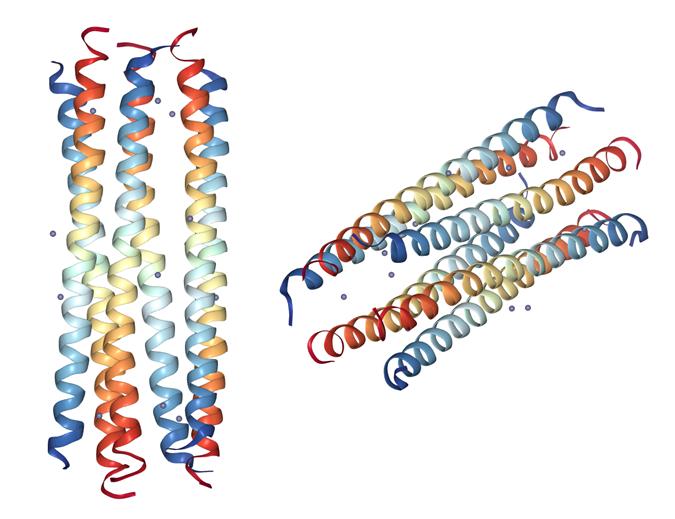
Chemical Structure
Dermcidin-1L (human) . TFA
AG-CP3-0039
CAS Number478898-18-9
Product group Chemicals
Estimated Purity≥95%
Molecular Weight4818.5 . 114.0
Overview
- SupplierAdipoGen Life Sciences
- Product NameDermcidin-1L (human) . TFA
- Delivery Days Customer10
- CAS Number478898-18-9
- CertificationResearch Use Only
- Estimated Purity≥95%
- Molecular FormulaC210H359N57O71 . C2HF3O2
- Molecular Weight4818.5 . 114.0
- Scientific DescriptionChemical. CAS: 478898-18-9. Formula: C210H359N57O71 . C2HF3O2. MW: 4818.5 . 114.0. Dermcidin is an antimicrobial peptide constitutively expressed in sweat glands, secreted into the sweat and transported to the epidermal surface. In sweat it is proteolytically processed to Dermcidin-1L (DCD-1L) that has antimicrobial activity against a variety of pathogenic microorganisms and other peptides (e.g. DCD-1, Y-P30). Dermcidin-1L (DCD-1L) is a 48-amino acid antimicrobial peptide (AMP) with a Leu residue on the C-terminus, secreted in sweat and part of the innate host defense of the immune system. Unlike most AMPs, which are cationic, DCD-1L has a net negative charge. DCD-1L displays antimicrobial activity thereby limiting skin infection by potential pathogens in the first few hours after bacterial colonization. Highly effective against E.coli, E.faecalis, S.aureus and C.albicans. DCD-1L is first monomeric in human sweat. DCD-1L interaction with negatively charged bacterial membrane phospholipids leads to Zn(2+) dependent formation of oligomeric DCD-1L complexes in the bacterial membrane, which subsequently leads to ion channel formation resulting in membrane depolarization and bacterial cell death. The gene products of DCD have been reported to be a neuronal survival factor, a putative oncogene in breast cancer and a proteolysis-inducing factor (PIF) that induces skeletal muscle proteolysis to cause cancer cachexia. - Dermcidin is an antimicrobial peptide constitutively expressed in sweat glands, secreted into the sweat and transported to the epidermal surface. In sweat it is proteolytically processed to Dermcidin-1L (DCD-1L) that has antimicrobial activity against a variety of pathogenic microorganisms and other peptides (e.g. DCD-1, Y-P30). Dermcidin-1L (DCD-1L) is a 48-amino acid antimicrobial peptide (AMP) with a Leu residue on the C-terminus, secreted in sweat and part of the innate host defense of the immune system. Unlike most AMPs, which are cationic, DCD-1L has a net negative charge. DCD-1L displays antimicrobial activity thereby limiting skin infection by potential pathogens in the first few hours after bacterial colonization. Highly effective against E.coli, E.faecalis, S.aureus and C.albicans. DCD-1L is first monomeric in human sweat. DCD-1L interaction with negatively charged bacterial membrane phospholipids leads to Zn(2+) dependent formation of oligomeric DCD-1L complexes in the bacterial membrane, which subsequently leads to ion channel formation resulting in membrane depolarization and bacterial cell death. The gene products of DCD have been reported to be a neuronal survival factor, a putative oncogene in breast cancer and a proteolysis-inducing factor (PIF) that induces skeletal muscle proteolysis to cause cancer cachexia.
- SMILESN[C@@H](CO)C(N[C@@H](CO)C(N[C@@H](CC(C)C)C(N[C@@H](CC(C)C)C(N[C@@H](CCC(O)=O)C(N[C@@H](CCCCN)C(NCC(N[C@@H](CC(C)C)C(N[C@H](C(NCC(N[C@H](C(N[C@@H](CCCCN)C(N[C@@H](CCCCN)C(N[C@H](C(N[C@@H](C(C)C)C(NCC(NCC(N[C@@H](CC(C)C)C(NCC(N[C@@H](CCCCN)C(N[C@@H](CC(C)C)C(NCC(N[C@@H](CCCCN)C(N[C@H](C(N[C@H](C(N[C@@H](C(C)C)C(N[C@@H](CCC(O)=O)C(N[C@H](C(N[C@@H](CC(C)C)C(N[C@@H](CCC(O)=O)C(N[C@@H](CO)C(N[C@@H](C(C)C)C(NCC(N[C@@H](CCCCN)C(NCC(N[C@H](C(N[C@@H](C(C)C)C(N[C@H](C(N[C@H](C(N[C@@H](C(C)C)C(N[C@@H](CCCCN)C(N[C@H](C(N[C@@H](C(C)C)C(N[C@@H](CC(C)C)C(N[C@H](C(N[C@@H](CO)C(N[C@@H](C(C)C)C(N[C@@H](CC(C)C)C(O)=O)=O)=O)=O)CC(O)=O)=O)=O)=O)CC(O)=O)=O)=O)=O)CC(O)=O)=O)CC1=CN=CN1)=O)=O)C)=O)=O)=O)=O)=O)=O)=O)=O)CC(O)=O)=O)=O)=O)C)=O)CC(O)=O)=O)=O)=O)=O)=O)=O)=O)=O)=O)=O)C)=O)=O)=O)C)=O)=O)CC(O)=O)=O)=O)=O)=O)=O)=O)=O)=O.FC(F)(C(O)=O)F
- Storage Instruction-20°C,2°C to 8°C
- UNSPSC12352200
